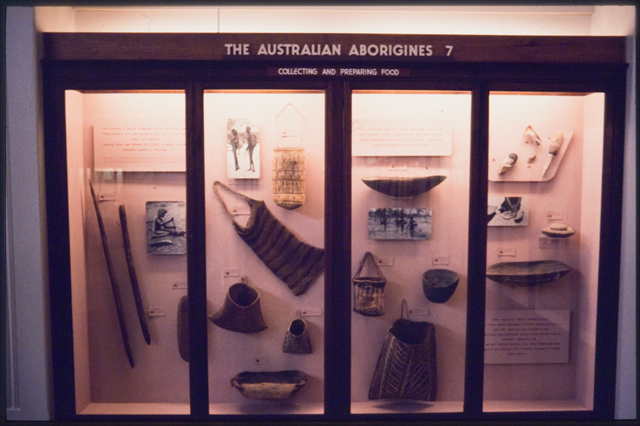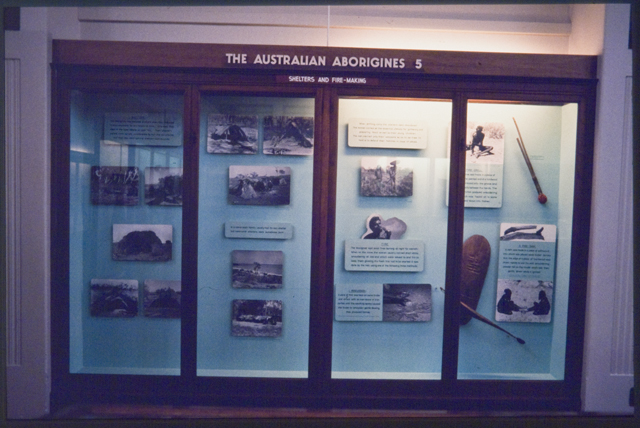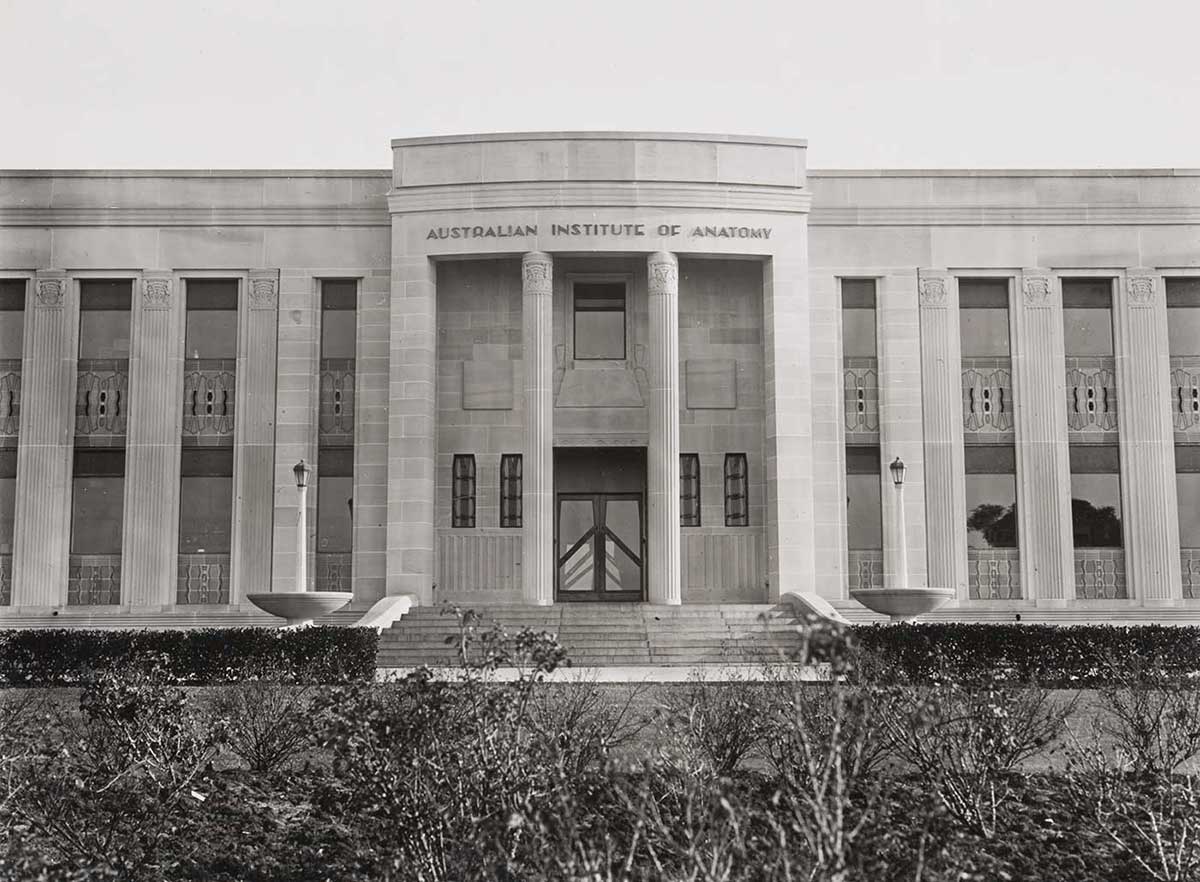The Australian Institute of Anatomy
The Basedow collection, which comprises Aboriginal artefacts as well as photographs, arrived at the Australian Institute of Anatomy in 1934. Within six weeks of Basedow’s death on 4 June 1933, his wife, Nell, and the Institute’s director, Sir Colin MacKenzie, were corresponding about Basedow’s papers. In her reply to Mackenzie’s letter, Nell enquired whether the Institute was interested in purchasing the collection:
I had been thinking of writing to you about his collection of native weapons & curios. No doubt you are aware that Dr. Basedow’s collection is the best privately owned in the Commonwealth, all personally collected from all over Australia during a period of over thirty years. Many of the articles once belonging to now extinct tribes, there are also some twenty skulls, & hundreds of photographs & various other things. As I will probably be selling the house, I was wondering if your Institute would buy the collection.
The following year the Commonwealth Government purchased the artefacts and photographs for £500. Basedow’s papers were not included, and they now reside at the Mitchell Library in Sydney. Basedow also collected geological and natural history specimens and it is thought he handed these over to institutions such as the South Australian Museum and University of Adelaide, soon after returning from his various expeditions.
From the 1960s, one of the Institute’s two galleries was devoted to displays of indigenous cultures. Photographs and artefacts from several collections were incorporated into these displays. The Basedow photographs were the single largest collection held by the Institute and due to the high quality and broad-ranging nature of his photographs, images from this collection comprise the largest group used in the displays. Several artefacts collected by Basedow were also incorporated in the displays, but these cannot always be recognised from photographs of these displays (see display images below).
The Institute closed in 1984, and its collection of Basedow’s photographs became part of the National Historical Collection, housed at the National Museum of Australia.
Piecing the collection together
My relationship with Herbert Basedow has been a long one. I first came across his photographs in 1979, shortly after I joined the Australian Institute of Anatomy in Canberra. Sitting in the corner of my office was a filing cabinet storing hundreds of prints mounted on thin sheets of cardboard. Most were labelled as having been taken by ‘H. Basedow’. In an old-style bookcase just outside my door I found negatives of the prints stored in paper envelopes in specially made wooden boxes and many more still in their original negative boxes. With them were hundreds of glass lantern slides in old cigar boxes.
I was fascinated by the photographs. There were images of Aboriginal people hunting, preparing food and performing ceremonies, as well as portraits, group photographs and images of rock art. Others were of outback stations, landscapes and rock formations, and trees blazed by early explorers. One group of photographs showed non-Aboriginal peoples with a range of vehicles, mainly buggies, but also cars and camel trains. I was intrigued. Who was H Basedow and what did this amazing collection of photographs represent?
As I delved deeper, I began to build a detailed picture of Herbert Basedow. He is better known for his four-month stint in 1911 as the Chief Medical Inspector and Chief Protector of Aboriginal peoples in the Northern Territory, than for any other parts of his life – and his was a life of many parts. He was a major collector of botanical specimens, and he discovered several new species of plants, some of which bear his name. A qualified medical doctor, he pursued many other fields of scientific knowledge, including geology, zoology and anthropology, an area of study in its infancy at the time. Basedow could be described as Australia’s first ‘home-grown’ professional anthropologist. But it was Basedow, the photographer, who really intrigued me.

Piecing together the clues to Basedow’s life – and the photographs in the Institute’s collection – was a painstaking process. The documentation of the photographs was limited and in many cases did not include anything more than Basedow’s name. The prints mounted on card were mostly of Aboriginal people but there were also some of non-Aboriginal subjects. As I better understood Basedow’s work it became apparent that, apart from a small group of family photographs, the photographs were all related to his expeditions. This insight had been partly masked because the prints had been arranged by subject. When I decided to reorganise the photographs by expedition, it was a major breakthrough, for now the images were arranged by place and time, and related photographs could be grouped together, even if they showed different subjects.
Given the dearth of documentation, this was no easy task. As I became more familiar with the photographs, trends became apparent. The same people and vehicles, for example, featured in a range of photographs. Also, Basedow had published many of the images and from these I had a base group for reference. The Institute had some of Basedow’s publications and I began to locate others. He published widely, in anthropology in particular, but also geology and, early in his career, zoology. Photographs were included in most of his publications. I also consulted his papers at the Mitchell Library in Sydney and books of newspaper cuttings relating to Basedow at the State Library of South Australia.
During this research I discovered more photographs that could be attributed to particular expeditions among the negatives and slides that had not been printed. The Institute had its own dark room, so I began to make prints of photographs that had not been printed.

Over the next few years I continued to build a profile of this fascinating man. At the Mitchell Library, which holds most of Basedow’s papers, I trawled through Basedow’s prints, some loose and some in albums, gleaning what information I could to assist in documenting the photographs. I soon noticed inconsistencies in the labelling of some of the prints in the library and that the documentation contained errors. To compound the problem, the Institute had borrowed Basedow’s papers from the library in the 1960s and had incorporated these inaccuracies onto the records. So the task of improving the documentation now included working out what information was correct and what was not. The errors included incorrect dates and placements; in others it was the subject of the photograph. Unfortunately, some of these mistakes found their way into Basedow’s second book, Knights of the Boomerang, published two years after his death. These errors were made by whoever labelled the prints, not by Basedow.*
Once Basedow’s publications and papers had been consulted, there were still many photographs that remained undocumented. It was now time for some lateral thinking. I noticed that some of the negative forms were glass and some were film, and that they came in many sizes. This reflected Basedow’s use of different cameras at different times, and the fact that sometimes he took more than one camera on an expedition. Eventually, I worked out which negative forms related to which expedition. Occasionally a negative form was specific to one expedition while some were used on several different trips. This is where knowledge of who the people were in the images or the landscapes depicted proved useful. For example, the square format film negative was used on four expeditions between 1903 and 1926; two in central Australia and two in the far north. In each case the personnel and modes of transport were different, as was the nature of the country between the two regions. Once the expedition was determined, at the very least this provided a year and approximate location of where the photographs were taken.
Basedow's legacy
Since his premature death in 1933 at the age of 51, Basedow has all but faded into obscurity. Little information is available about him beyond an entry in the Australian Dictionary of Biography or his collections of artefacts and photographs. His publications are only occasionally cited yet aspects of his anthropological work, such as information gathered around Darwin, are essential to research in this area.
Basedow left behind a significant legacy. In addition to his photographs, his published works are important sources of information, and his collections of Aboriginal artefacts and geological, plant and animal specimens are large and varied. A Different Time: The Expedition Photographs of Herbert Basedow 1903–1928 gives Basedow some of the recognition he has long been due.
Note
* For example, different photographs of the same Aboriginal man were published in The Australian Aboriginal, Basedow’s first book, and Knights of the Boomerang. In the former he is said to be a Wardaman man, which we can assume to be correct given that Basedow was involved in its publication. In Knights of the Boomerang he is said to be a Warramunga man. In ‘Manipulation of photographs: a case study’, COMA: Bulletin of the Conference of Museum Anthropologists, vol. 14, 1984, pp. 2–20, I corrected many of these errors (corrections in COMA, vol. 15, 1984, p. 25).
This is an edited extract of the ‘Introduction’, A Different Time: The Expedition Photographs of Herbert Basedow, 1903–1928 by senior curator David Kaus.
- Download Introduction1.1 mb pdf [ PDF | 1.1 mb ]
You may also like
References
Nell Basedow to Colin MacKenzie, 22 July 1933, National Archives of Australia A2645, 50/2/1.
